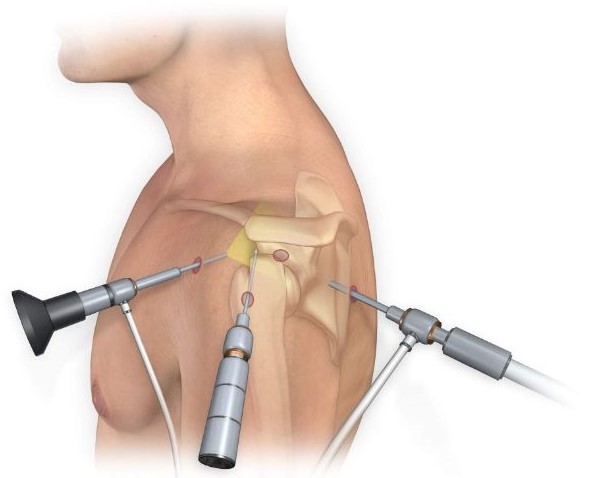An extensive range of shoulder injuries can be successfully treated with arthroscopic shoulder surgery. During a shoulder arthroscopy, the tissues surrounding and inside the shoulder joint are examined and repaired using a tiny camera, an arthroscope, and thin surgical instruments which reduce pain and hasten recovery by treating a shoulder injury with extremely small incisions.
Arthroscopic shoulder surgery is used to treat several shoulder injuries, including:
- Rotator cuff injuries
- Shoulder fractures
- Dislocated shoulder and shoulder instability
- Labral and SLAP tears
- Frozen shoulder
- AC joint injuries/arthritis

What is shoulder arthroscopy surgery?
Shoulder Arthroscopy Surgery is a type of surgery that is less invasive and is used to both diagnose and treat issues with the shoulder. It can be utilized for conditions like rotator cuff tears or shoulder impingement. This approach involves making smaller incisions compared to traditional surgery, with each incision being similar in size to a keyhole.
During the procedure, a small camera known as an arthroscope is inserted through a tiny incision in the skin. This camera then transmits images of the shoulder joint to a video screen, allowing the medical provider to examine and identify the root cause of the injury. If repair is necessary, miniature surgical tools are used to restore mobility to the shoulder. A proper procedure before, during, and after the surgery is carried out by doctors.
What is the purpose of Shoulder Arthroscopy Surgery?
Shoulder arthroscopy surgery is performed to address shoulder pain that hasn’t improved with non-surgical interventions. These interventions may include physical therapy, medication, injections, and rest.
When to Contact Your Doctor
When should I contact my healthcare provider?
Reach out to your healthcare provider if you experience any of the following symptoms following your surgery:
- Fever after surgery.
- Pain unresponsive to medication.
- Presence of discolored or foul-smelling fluid around the wound.
- Tingling or numbness.
- Increased swelling.
Potential Complications & Benefits of the Surgery:
Complications
General complications associated with anesthesia and surgery include:
- Allergic reactions to medications
- Respiratory issues
- Bleeding, blood clotting, and infection
Risks
Specific risks of shoulder arthroscopy encompass:
- Shoulder stiffness
- Inadequate relief of symptoms post-surgery
- Weakening of the shoulder
- Injury to blood vessels or nerves
- Damage to the shoulder cartilage (chondrolysis)
Benefits
- It can usually be carried out as an outpatient procedure
- Swelling, pain, risk of complication, and infection are substantially less due to the minimally invasive approach
- Shorter hospital stay and much lesser recovery time
- Usually more successful than open joint procedure
- Both diagnosis and surgery can be carried out in one approach.
- The use of tiny instruments in arthroscopy aids in minimal damage to surrounding tissues compared to large-sized surgical devices
Details of the procedure
-
Before the Procedure
Your healthcare provider will review your medical history and medications.
To ensure readiness for the procedure, you may undergo blood tests, a chest X-ray, and an electrocardiogram (ECG).
-
After Shoulder Arthroscopy Surgery
It’s an outpatient procedure, allowing same-day discharge. Recovery typically lasts an hour or two at the hospital. Pain medication is provided.
Recovery following Shoulder Arthroscopy Surgery
After the procedure, your surgeon may advise certain practices to enhance your recovery. You’ll be prescribed pain medication, and a bandage will be wrapped around the operated shoulder, which can be removed after 24 hours. Dressings may be applied to cover the wounds. It’s normal to experience slight swelling in the shoulder post-surgery. Applying ice packs to the shoulder for approximately 20 minutes, 3-4 times daily, can help reduce swelling. You can resume normal activities once you feel comfortable, and a follow-up appointment should be scheduled 7-10 days after surgery to monitor your progress.